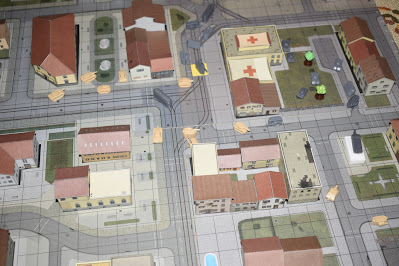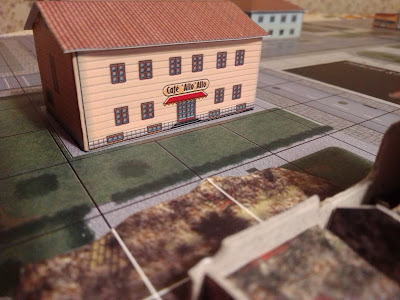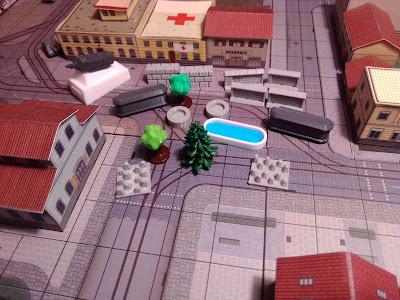This article will be about the rules aspect of the game,
and the actual gameplay.
We tried out the core rules. Compared to the dynamic set,
this is more robust and complex, and I would say a more realistic set of rules. It reminds me strongly of GMT's Panzer, and I have a feeling that the upcoming Advanced upgrade set will just highlight this even more.
Lets cover the information cards first. You have your
point cost for the given rules set, the miniature/figure image for ease of
recognition, than several movement based stats, such as max speed if not
reversing, reverse, drive type etc.. Than you have the armor stats, for the front, side,
back, top and tracks.. Next is the weapons with the range, which accuracy dice
to use, penetration of the gun, type of ammo (AP or HE for now, with more to
come in the advanced upgrade), weather the gun can fire point blank or not, and
the range for parabolic fire. The cards do look good, and all the relevant information is displayed, along with some bits that are not being used for now (like weight).
The core rules have several sets of dice with specialized
symbols on them, though most of which will be used later in the upcoming
Advanced upgrade expansion. The first one you use is the speed die, which
similarly to Forsage’s Age of dogfights series is rolled just before activating
a unit, and it brings a spot of randomness to the speed of any given vehicle.
It could remain the same, or go -1 or +1. This does slow the gameplay a bit, as
you have to roll multiple times during your turn, but the random factor it
creates is amazing, as you can never be 100% certain if your vehicle will manage
to cross the open street in its turn or will it get stuck just before going
round the corner. I have a feeling this will be more expanded upon in the
Advanced upgrade expansion, with the mentioned cruising speeds, and engine
overheating.
Next you have 4 separate sets of accuracy dice, in pairs
of 2. They are color coded, so green for worst, blue is slightly less bad,
purple is good and red is best. Every vehicle has its dice set in the
information cards (so for example red for the panther, blue for the 75mm
sherman..), but again this could change in the future given the idea of crew
experience. When you pick your target, you measure the range with the ruler and line of sight,
and roll your designated pair of dice. To hit the target you must roll equal to
or higher than the range. The better the pair of dice, the greater your chances
are.
Here I must point out how player friendly this system
really is. The accuracy dice are color coded, but they are also numbered, which
at first glance creates confusion, as you search for the third purple die etc.
In fact, the numbering is for color blind players, to easily identify the set
they need. 1 for green, 2 for blue, 3 is purple and 4 is red. Bravo Forsage!
If you hit the target, you must then roll a hit die. This
might have been a poor choice for a name, as you have already rolled your dice
to hit the target, thus making this a Location dice perhaps. You can’t really
call it just a white die as there are 2 more of that color too, plus 2 more colored
that you can roll for location. This die will tell you if you hit the tracks or
the body, with the tracks being 1 in 6 chance. Each side has multiple other
markings that are meant for the advanced upgrade, so I can’t comment on them
now. But if you are close enough to the target (depending on the color of your
accuracy dice) you can declare you are trying to hit the tracks on purpose,
perhaps having no chance of penetrating the target from that angle, or in fact
you want to make certain you hit the body and avoid wasting a powerful shot
just to immobilize the target. These dice also have multiple other symbols on
them, where only two X’s are used
currently. If you moved and rolled the red X than you missed, and if you have a
hull mounted weapon and rolled a white X than that’s a miss as well.
Now you reference the ruler, as AP weapons degrade their
penetration power, check the armor value depending on the angle of the attack,
and roll another die. This one is very similar to the speed die, and can push
the penetration even further with +1,+2.., do nothing or even decrease the
power. These again have multiple symbols on them not used in the current game. There is even the option for even more angles, instead of just front, side and rear. If the end result has the penetration total greater than the armor value the
target has been destroyed. If its equal than its damaged, which for now, has only 2
options. If the body was hit than the crew was injured. Place a marker for it,
and this will do what you expect, no more move than fire. If the tracks were
hit than the process is different depending on the drive of the vehicle. In
short, the first time the tracks are damaged, the vehicle can still move, but
with difficulties, while the second time it gets damaged, its then immobilized
and no movement is possible. Repairing damaged vehicles is also possible, either by
the brave crew, or a recovery vehicle (which is a bit faster, but you must buy
the vehicle first). The crew can be attacked while repairing the vehicle, thus
restarting their effort or destroying the vehicle.
The damage markers are a bit dull to be honest. The crew
marker is fine, a semi transparent plastic with a crew symbol sticker on it.
The immobilization and destroyed markers are yellow and black large square
pieces that slide under the vehicle. The immobilization could have been the
same as the crew one, with the sticker being like a damaged cog or something.
The destruction marker I guess is supposed to represent the smoke plume
spreading around the vehicle, covering the whole space where the vehicle is,
but we find that just tilting the vehicle on its side does the job as well. We
need to play more, and see if the black marker will in fact create more cover
for units behind it. I suspect there will be several more types of damage later
on in the game, which I am looking forward to.
The game comes with some other markers as well, like the
timer cubes, used for repairing (it takes time to finish the repairs) or some
scenario specific goal where the infantry need some time to capture a
building.. These are plastic cubes with stickers for them, and do the job well
as they are small and don’t get in the way too much. The activation markers on
the other hand are as big as some of the vehicles, so when playing with lots of
vehicles on the board, this can get even more crowded. We didn’t use them, as
we just remembered who has yet to activate. They are necessary, but should
have been way smaller than they are now.
Let’s talk about movement for a second. I won’t cover all
the details, but there are separate rules for moving tracked and wheeled
vehicles (which makes sense). The one thing we didn’t like with the movement
rules, is the coordinated movement. It states that depending on the total
number of vehicles you have you get a certain number of coordinated moves. This
does sound like activating and moving several vehicles at the same time, sorta
like a platoon (and in fact we might try it like this), but the rules state
that the player moves all of his vehicles, than performs his shooting if
possible, then play switches to the other player. So activating several vehicles at a time serves no purpose. This is confusing as the number of activations is on the low
side, and the rest of the vehicles can then move just one space. I don’t think
we are reading this wrong, as the wording is clear. The intention was to show
the confusion of battle, and the fact that the commander can’t be everywhere at
the same time to direct everyone. When we played, we skipped this bit, and just
activated every vehicle in full. This hasn't slowed play at all. Again we will experiment with creating and
activation platoons one at a time, using this rule, interpreting the rule as a
number of coordinations the commander can perform to his platoon commanders.
This sounds good on paper, as the terrain density of the board WILL cause you to divide
your forces into smaller groups.
Now, on to artillery. I LOVE it! Unlike Tank chess, where
artillery pieces were rarely useful due to low range and the way shooting is
conducted in a straight line, here you have a feeling your batteries are an
integral part of your plans. You have medium and heavy SP howitzers, and medium
and heavy field howitzers. Their range is,
although not realistic, very good in game, allowing you to cover a large
portion of the board. Obviously you will want to use cover as much as possible. This way your guns will require an observer to operate. You
can have any one of your other vehicles be the observer for the turn and report the
position of the target. The rules get even more cheeky here, and mention that
not all of the vehicles in the game were historically equipped with a radio, in
case you want to go full grognard. This will make your light tanks and armored
cars super useful. Ok, so how does this work? First when you activate the
observing model, you check if it already has a line of sight to the target
(this is not modified by cover). If it has, the die roll to report the
coordinates for the strike is much easier. If not, it has to move to get into a
better position, which in turn makes the roll much worse. To fire, your
battery places a template next to it self to check if parabolic fire is possible,
then places the template next to the target to see if it is possible to hit it,
or it is too close to a building. You then roll the accuracy dice as usual,
followed by a new die to see which part of the target you hit, which makes it
possible to hit the top armor. If you didn’t hit your primary target, you then
roll two lets call them scatter dice, which will show you if your shot scatters
into any of the 8 spots around it, or if it missed. I love this so much, how a
simple boardgame can make artillery fire so involved, unlike some more famous
miniature games that ignore the concept of scattering into a new target. For now
there is no smoke in the game, but i’m sure it would be easy to add it in later. Like once per game/per battery, a large white square
template/marker 3x3 squares in size, can fire on open ground, place a timer on
it to mark its duration, lets say based on the number of guns firing smoke, lasts two
turns per weapon.
Onto the vehicles then. We played with the core rules,
and historic pieces. These don’t allow the Germans an armored car, which is a
shame, an sdkfz 222 would fit perfectly, either the standard autocannon model,
or the pzbuche41. Also the T38 being super obsolete and yet with poor
performance for a light tank could have been a Pz II “Luchs”. A perfect fit for
a scout. More speed, less AT. We will have to playtest this into our games. The
wife had some 3 platoons of shermans with a firefly each, and a platoon of
stuarts, while I rolled a platoon of pzIV’s, panthers, a single tiger I, and a
pair of hetzer’s and t38’s. I tried to make a balanced choice, similar to what
I would use in let’s say Flames of war. The difference between the vehicles in
the same category could be felt, as the t38’s were cr*p obsolete, while
the stuarts were zipping about. The shermans felt average as there were many of
them, the fireflies were a precious commodity. My tiger and panthers were doing all the work, while the rest were trying to get into
flanking positions. They all felt balanced, though we still have many more to
try out.
Now, what we felt is a missed opportunity here, the Germans could have an armored car, the light tank could be a different one, there are
no stugs, but there is the maus, there is an SPAA vehicle with no clear purpose
as there are no planes. The allies on the other hand are a strange bunch, with
a mix of American and British vehicles, not really here, nor there. In fact, if
you take away some 3-4 vehicles, the rest are pure British. We felt that by
adding a few models to each group there could have easily been
2 separate armies for the allies.
We're not even sure how long our first game lasted, as we were so involved in the game, which is a very good sign, but I would say no more than 90 minutes. There was almost no checking of the rulebook during gameplay. At first glance there was some confusion with the vehicles, as these basic pieces have a few that kinda look alike. We felt like we would end up having to print out or otherwise buy some 6mm historical pieces, but I can honestly say that after a few turns you get used to what each piece is.
We loved the game, and can't wait to try out all the different vehicles. I hope that at some point in the future this game gets an eastern front variant with more open spaces. We recommend this to both board-gamers AND miniature wargamers as it has something for both groups.
This leaves us with a third article based on the dynamic set of rules for next time.



























































